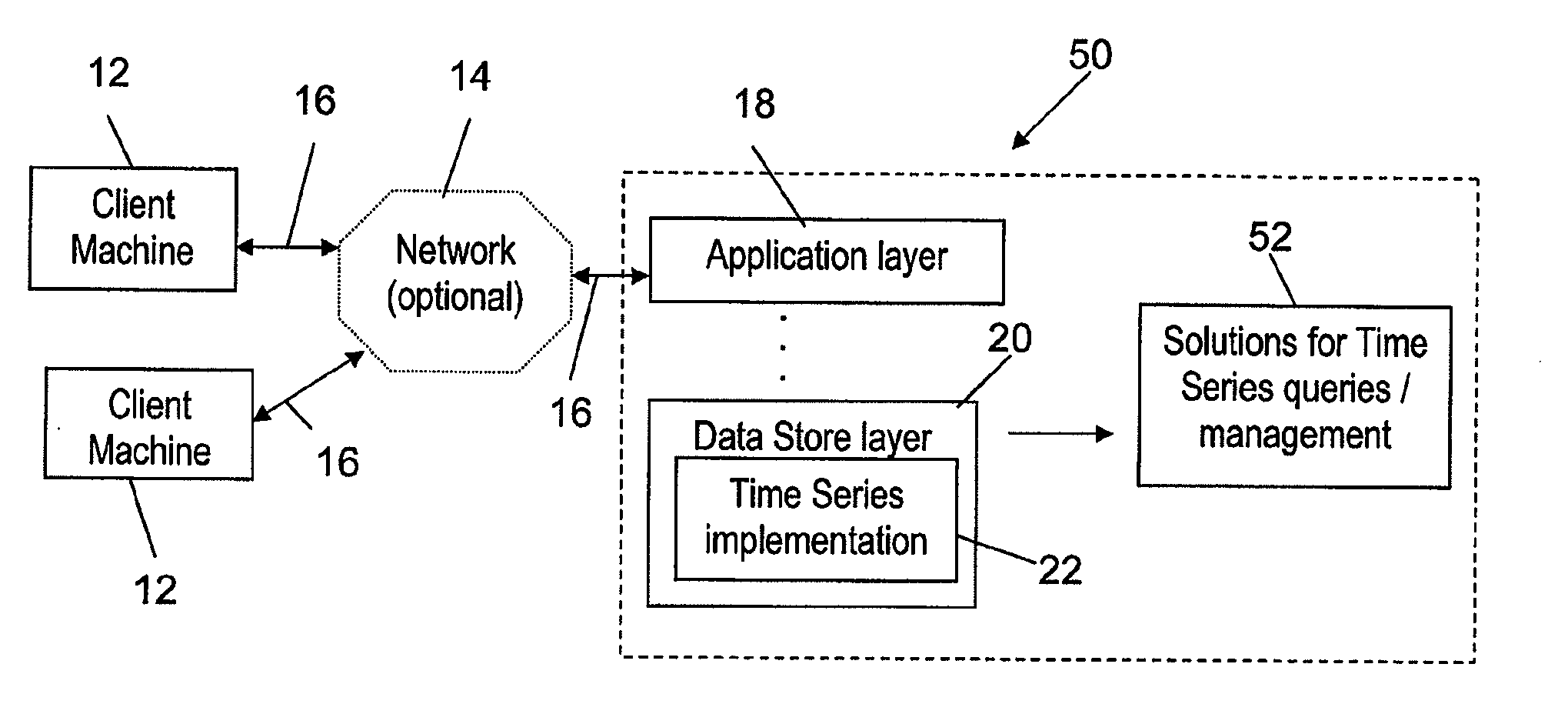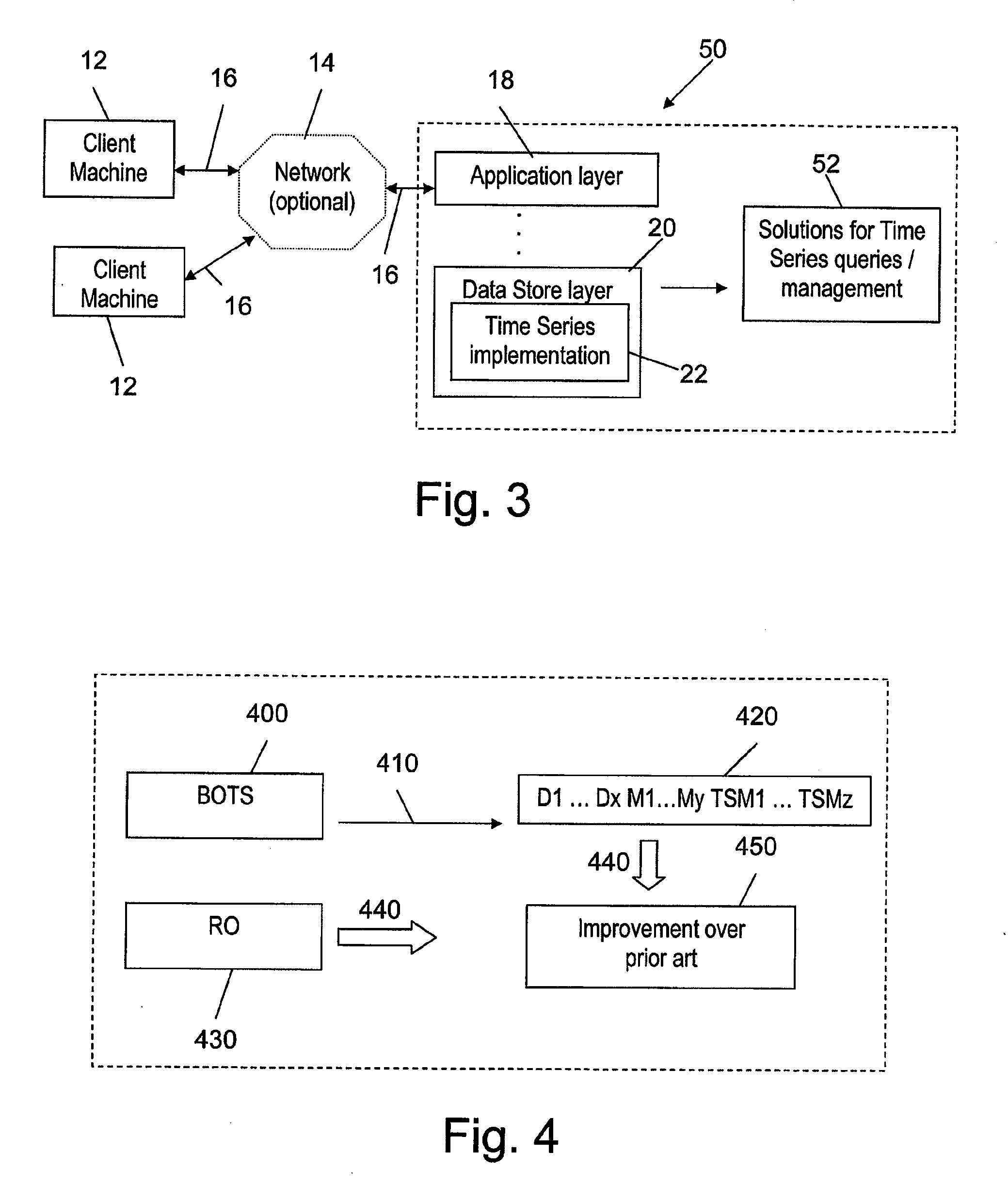Methods for effective processing of time series
a time series and processing technology, applied in the field of effective processing of time series, can solve the problems of data evolution undoubtedly putting time at the focus of users' curiosity, serious damage to the end user, and challenges in the field of data processing
- Summary
- Abstract
- Description
- Claims
- Application Information
AI Technical Summary
Problems solved by technology
Method used
Image
Examples
example 1
[0048]Assume the following user query: ‘Show stock of Cola for each month of period starting from January 2008 and up to December 2008’.
[0049]Table 1 shows data entries in the data store layer and the user system uses YTD (Year To Date) time series.
TABLE 1ProductDateQuantitydimensiondimensionmeasureColaJanuary 200810ColaMarch 20085ColaApril 200816ColaNovember 20087
[0050]A possible scheme of query processing in a conventional user system may be as follows. For each requested date in a given query, the application layer of the user system would compose a separate query and send this query to the data store layer of user system. This query contains logic for YTD calculation according to a specific date hard coded in the query. Then the results of all the queries would be combined into a single query result and sent to the user.
[0051]The composed queries in SQL may be defined as follows:
Select product, ‘Jan2008’, measureFrom tableWhere product = ‘Cola’ and date in (‘Jan2008’);Select pro...
example 2
[0055]The user system uses YTD time series. BOTS for YTD time series measure may be defined in a data store layer as follows:
: starting from the year of a given date, and up to the given date>
[0056]Since the data store layer ‘knows’ the meaning of YTD, there is no need to rewrite the original query in order to explain which data entries exactly should be taken for YTD measure calculation of each date. So in the case of a user system configured according to the invention the query in SQL may be defined as follows:
Select product, date, measure_YTDFrom tableWhere product = ‘Cola’ and date in (‘Jan2008’, ..., ‘Dec2008’);
[0057]Query Processor collects the following data entries from data store for this query:
‘ColaJan200810’‘ColaMar20085’‘ColaApr200816’‘ColaNov20087’
[0058]The calculation of measure_YTD would be executed with all the data entries above as an input. For each requested prefix ‘product date’ Query Processor combines all the data entries above into a single intermediate...
example 3
[0064]FIG. 7 schematically shows time series data entries of a stock market that trades two stocks A and B in both the conventional and RO. The input data stream consists of pairs (stock id, price) ordered by the time of their appearances. The time series data in the conventional art 700 is an interleaved arrangement of data for both stocks as follows:
(A, $5, 5.5 pm: January 2008), (B, $105, 5.5 pm: January 2008) (A, $2, 5.7 pm: January 2008), (B, $115, 5.7 pm: January 2008) . . . .
[0065]The same time series in the Reverse Order 710 will consist of distinct streams for each stock id, e.g. stream 720 for stock A and 730 for stock B. Thus, each stream will represent the history of a specific stock in time. In the RO 710 the original time series 700 is represented as follows:
(A, $5, 5.5 pm: January 2008), (A, $2, 5.7 pm: January 2008) . . .
[0066]and
(B, $105, 5.5 pm: January 2008), (B, $115, 5.7 pm: January 2008) . . . .
PUM
 Login to View More
Login to View More Abstract
Description
Claims
Application Information
 Login to View More
Login to View More - R&D
- Intellectual Property
- Life Sciences
- Materials
- Tech Scout
- Unparalleled Data Quality
- Higher Quality Content
- 60% Fewer Hallucinations
Browse by: Latest US Patents, China's latest patents, Technical Efficacy Thesaurus, Application Domain, Technology Topic, Popular Technical Reports.
© 2025 PatSnap. All rights reserved.Legal|Privacy policy|Modern Slavery Act Transparency Statement|Sitemap|About US| Contact US: help@patsnap.com



